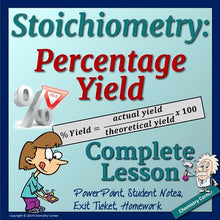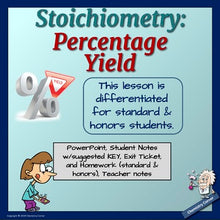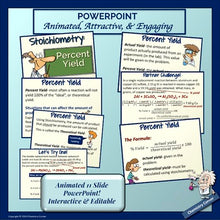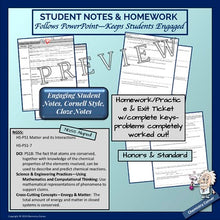This NGSS aligned lesson builds on the stoichiometry and limiting and excess reactants concepts.
The emphasis of this lesson is on concept development of percent yield. Students will distinguish between actual yield, theoretical yield, and percentage yield. Conceptually, students will understand that the percent yield tells chemists about the efficiency of a reaction. Chemists can then work to improve efficiency in several different ways, and increase percent yield. Students will calculate percent yield given the actual amount and the amount of reactant(s).
The homework and exit ticket are differentiated for honors and standard classes.
This lesson goes well with my Conversion Game-The Stoichiometry Edition. Or, try the Stoichiometry Scavenger Hunt, or stoichiometry task cards with white boards to give students more practice.
Objectives:
-
Distinguish between theoretical yield, actual yield, and percentage yield.
-
Calculate the percentage yield for a chemical reaction given the actual yield and amount of reactant(s).
NGSS:
HS-PS1 Matter and its Interactions
HS-PS1-7: Use mathematical representations to support the claim that atoms, and therefore mass, are conserved during a chemical reaction.
DCI: PS1B: The fact that atoms are conserved, together with knowledge of the chemical properties of the elements involved, can be used to describe and predict chemical reactions.
Science & Engineering Practices—Using Mathematics and Computational Thinking: Use mathematical representations of phenomena to support claims.
Cross-Cutting Concepts—Energy & Matter: The total amount of energy and matter in closed systems is conserved.
Prior Knowledge for Students: Students should be comfortable with dimensional analysis, nomenclature, molar mass, writing chemical equations for reactions, mole conversions, basic stoichiometry, and limiting and excess reactants prior to this lesson.
Teacher Prep Time: Just print and go!
Lesson Duration: One class period plus practice.
Included in This Product:
-
Editable, Animated PowerPoint (11 slides)
-
Cornell Style Student Notes that follow the PowerPoint (Cloze Notes)
-
Student Example of Completed Notes
-
Homework/Practice assignment w/KEY—all problems completely worked out (Honors & Standard)
-
Check for Understanding (exit ticket) w/KEY (Honors & Standard)
-
Teacher Notes
Note on the PowerPoint: The PowerPoint included in this product is editable. It is also animated, which means that it may appear busy or overlapping in the slide edit mode, but will be awesome in the slide show mode! Please don’t edit the PowerPoint until you have seen it in the slide show mode!
This lesson is appropriate for grades 9-12 chemistry.
This will be a lesson you will want to use year after year!
Chemistry Corner
**************************************************************************************
Check out these other products that you may be interested in:
Stoichiometry: A Complete Lesson
Chemistry Board Game Conversion- Stoichiometry Edition
Stoichiometry Scavenger Hunt with QR Codes
High School Chemistry Year Curriculum
*************************************************************************************
Chemistry Corner’s PowerPoints are perfect for the flipped classroom. However, please read the Copyright Terms below before using it as such. Thanks!
LICENSING TERMS: By purchasing this product, you own a license for one teacher only for personal use in your classroom. Licenses are non-transferable, meaning they cannot be passed from one teacher to another. No part of this resource is to be shared with colleagues or used by an entire grade level, school, or district without purchasing the proper number of licenses. I you are a coach, principal or district interested in transferable licenses to accommodate yearly staff changes, please contact beth@chemistrycorner.com.
COPYRIGHT TERMS: ©Chemistry Corner. Please note – all material included in this resource belongs to Chemistry Corner. By purchasing, you have a license to use the material, but you do not own the material. This resource, or any portion of this resource, may not be uploaded to the internet in any form, including classroom/personal websites or network drives, unless the site is password protected and can only be accessed by students—no other teachers or anyone else on the internet.








